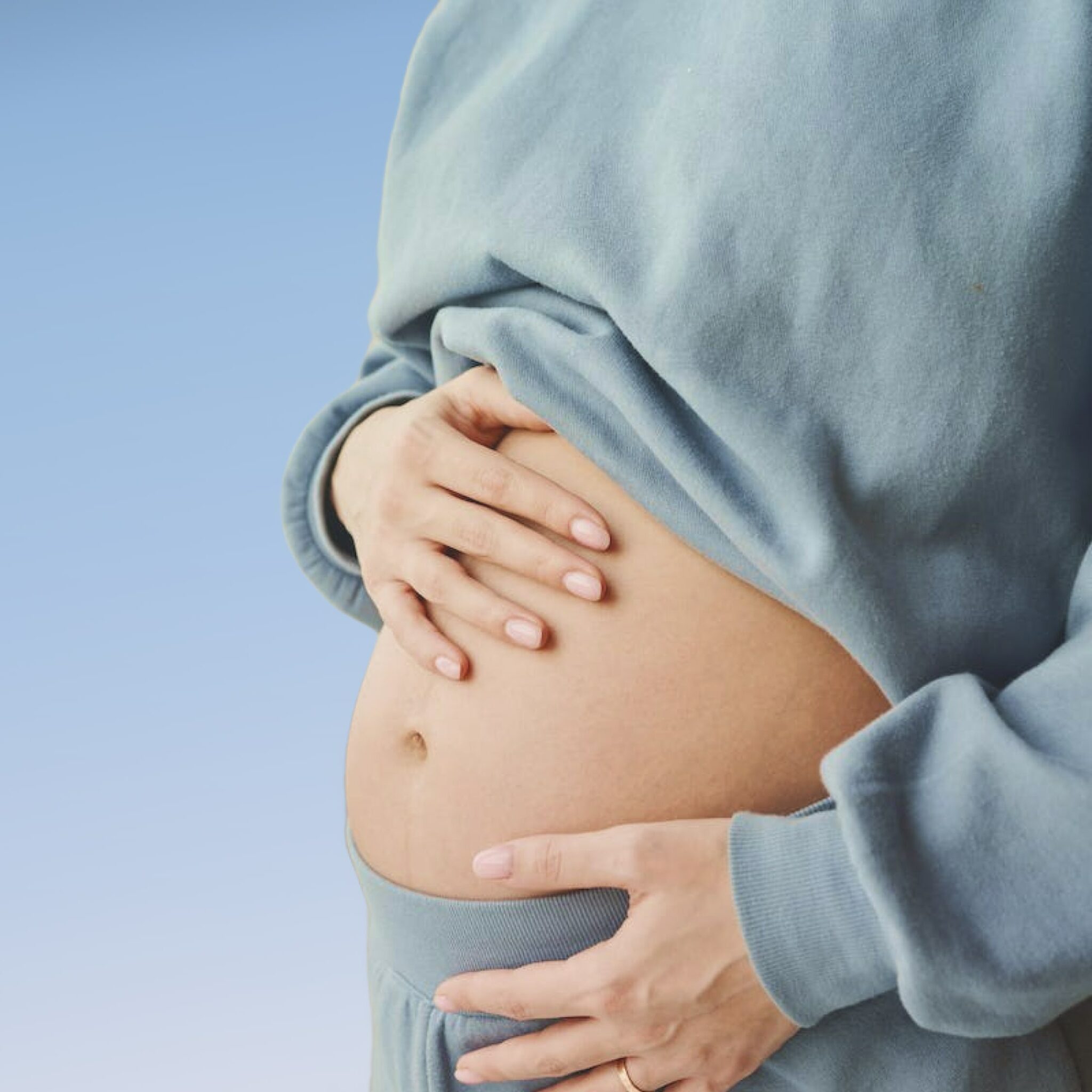This specialized form of exercise is known for its focus on core strength, flexibility, and balance, making it an excellent choice for a pregnant person or new parent. It promotes overall well-being, helps prepare the body for childbirth, and aids in recovery post-delivery.
Pregnancy Pilates
This comprehensive guide is here to help you understand how you can incorporate Pilates into your routine while pregnant to support you through each stage of your pregnancy and postpartum recovery.
From the do’s and don’ts of pre and postnatal Pilates to specific exercises for each trimester, we will cover it all.
Introduction to pregnancy Pilates
Pre and postnatal Pilates combines the principles of traditional Pilates with modifications and adaptations to accommodate the changes that occur in the body during pregnancy and the postpartum period.
One of the key benefits is that it is a low-impact form of exercise, making it safe for those who are pregnant to practice. It offers a gentle and effective way to stay active, maintain muscle tone, and alleviate discomfort to focus on a healthy pregnancy. Moreover, it can aid in preparing the body for the physical demands of labor and delivery.
The primary goal of Pilates is to strengthen the core muscles, including the pelvic floor, abdominal muscles, and back muscles. All important focuses when pregnant. These muscle groups play a vital role in supporting the growing belly, maintaining proper posture, and preventing common pregnancy-related issues such as back pain and pelvic instability.
In addition to strengthening the core, Pilates also emphasizes improving overall stability, flexibility, and balance. It incorporates controlled movements, breath work, and mindfulness to enhance body awareness and promote relaxation.
Breathing techniques and relaxation in pregnancy Pilates
Much like Prenatal Yoga, Pregnancy Pilates places a strong emphasis on breathing techniques and relaxation, both pivotal in enhancing well-being, mitigating stress, and readying your body for labor.
Breathing techniques help to foster body awareness, promote relaxation, and deliver oxygen to your muscles. These techniques not only provide stress relief while pregnant, but also improve muscle function and endurance, prevent fatigue, and facilitate core engagement and stability.
Relaxation in Pilates is equally important and offers a tranquil space for you to de-stress, concentrate on your well-being, and can help improve sleep quality, providing much-needed rest and rejuvenation.
Breathing techniques in Pilates
- Diaphragmatic breathing: Also known as belly breathing or deep breathing, involves inhaling deeply through your nose, allowing your belly to expand, and exhaling slowly through your mouth, drawing your belly in.
- Ribcage breathing: Focus on expanding your ribcage as you inhale. This technique helps improve lung capacity and encourages better posture.
- Pelvic floor breath: Inhale deeply as you relax your pelvic floor, and exhale while lifting and engaging these muscles. This technique helps create strength and promotes better pelvic alignment.
Relaxation techniques in Pilates
- Guided imagery: Visualize calming and serene scenes. Engage all your senses to experience a deep sense of relaxation.
- Progressive muscle relaxation: Start at one end of your body and progressively tense and relax each muscle group. Focus on releasing tension and promoting a state of relaxation throughout your body.
- Mindfulness meditation: Focus your attention on the present moment, your breath, bodily sensations, and thoughts without judgment. This helps cultivate a sense of calmness and presence.
Navigating prenatal Pilates
During pregnancy, it’s important to prioritize safety and listen to your body’s needs. Prenatal Pilates offers a multitude of benefits, but it’s crucial to focus on practicing a safe and effective workout.
Do’s of prenatal Pilates
- Consult with your healthcare provider
- Find a Pilates instructor that is certified for prenatal workouts
- Warm-up and cool-down
- Strengthen the core and pelvic floor muscles
- Modify exercises to accommodate pregnancy
- Listen to your body
Don’ts of prenatal Pilates
- Avoid exercises that cause excessive abdominal strain or intra-abdominal pressure.
- Avoid high-impact movements as pregnancy hormones loosen the ligaments and joints, making them more susceptible to injury.
- Don’t overstretch as the relaxin hormone released during pregnancy can make the joints more lax, increasing the risk of injury. Focus on gentle and controlled stretching instead.
- Don’t hold your breath during Pilates exercises so that oxygen can be delivered to your muscles.
- Avoid hot Pilates as pregnant people are more prone to increased body temperature and overheating due to increased blood flow and hormonal changes.
When diving into pregnancy workouts, it’s important to remember that like doula support, a lactation consultant, or a pelvic floor physical therapist, your Pilates instructor is one more person on your complete prenatal team to help ensure you’re happy, healthy, and more knowledgeable about your pregnant body throughout the process.
Choosing someone with prenatal workout experience or a certification in Pilates during pregnancy will help you navigate these do’s and don’ts with ease, as well as guide you through pregnancy exercise safely to help ensure a healthy pregnancy.
Prenatal Pilates: Trimester by trimester
Pregnancy is divided into three trimesters, each with its own unique set of changes and challenges. Here is what you can expect and how you should approach prenatal workouts in your exercise regimens for each trimester:
First trimester
You may experience fatigue, morning sickness, and hormonal changes. It’s important to listen to your body and make adjustments as needed but in general, you can keep moving as you have before. Focus on:
- Core engagement: Strengthening exercises for the deep abdominals and pelvic floor can help support your growing belly and maintain good posture during pregnancy. Remember that your body may already feel very different even though the belly might not show yet, so it’s important to listen to how you feel when working out.
- Gentle stretching: Incorporate stretches into your prenatal workout to alleviate muscle tension and promote flexibility. Gentle stretches for the back, hips, and legs can help relieve discomfort. Include exercises like seated forward bends, hip openers, and calf stretches.
- Breathing and relaxation: Practice deep diaphragmatic breathing techniques to promote relaxation and reduce stress. Incorporate breathing exercises such as belly breathing and 4-7-8 breathing. Consider adding relaxation exercises like guided imagery or meditation to help manage any anxiety or stress.
Second trimester
During the second trimester of pregnancy, many pregnant people experience increased energy levels, a growing baby bump, and extra weight. Focus on workouts that support your body while maintaining strength and stability. Focus on:
- Modified exercises for core strength: As your belly grows, adapt your core workouts to avoid excessive pressure and load on the abdominals. Avoid lying on your back for long periods of time, and keep your glutes active.
- Posture and alignment: Pay attention to your posture and alignment to reduce strain on the back and pelvis. Incorporate movements in your prenatal workout that promote good posture and strengthen your back muscles.
- Pelvic floor exercises: Continue to strengthen these muscles to support your baby and prepare for labor. Remember that relaxing the pelvic floor is as important as being able to activate it.
- Balance and stability: As your body changes, your balance may be affected. Focus on exercises that improve stability, such as standing leg lifts, single-leg balances, and modified lunges with support.
Third trimester
In the third trimester of pregnancy, your belly grows significantly, and you may experience more physical discomfort. Adapt your practice to accommodate your changing body and maximize comfort. In Prenatal Pilates, focus on:
- Gentle movements and stretches: Engage in exercises that promote relaxation and ease discomfort while pregnant. Incorporate gentle movements in your prenatal workout like side stretches, modified cat-cow stretches, and gentle pelvic rocks.
- Pelvic floor exercises and breathing: Continue to prioritize pelvic floor exercises and deep diaphragmatic breathing to prepare for labor and delivery.
- Modified movements for stability: As your body’s center of gravity shifts, focus on exercises that enhances stability and balance. Include exercises like seated or standing leg abduction, squats, and gentle hip circles.
- Relaxation and mindfulness: Incorporate relaxation techniques such as guided imagery, meditation, or prenatal yoga to promote calmness and reduce stress. Prioritize self-care and take time for yourself during this final stage of pregnancy.
Remember to always listen to your body during prenatal workouts, modify as needed, and consult with your certified health provider before starting or continuing any exercise program during pregnancy.
Online prenatal workouts
For expectant parents who are interested in Pilates during pregnancy, but would prefer the privacy and convenience of working out at home, you might consider turning to online prenatal workouts as opposed to live sessions.
Many online platforms will have prenatal workout series readily available or workout videos suitable for pregnancy. The beauty of Pilates is that it is easily adaptable, so even if classes range in difficulty, each exercise can be modified.
On-demand classes for prenatal Pilates should also guide you in any equipment required to either support you or appropriately challenge you through low-impact exercises, such as yoga blocks, resistance bands, or small weights.
Most platforms with on-demand classes will have a trial of unlimited access to free classes, so before diving into an annual membership, take the time to explore their offering to ensure instructors are safe and knowledgeable. And, of course, always check with your doctor before starting a new program while pregnant.
Postnatal Pilates: Regaining your strength
After the baby arrives, it’s time to focus on your postnatal recovery and regaining your strength. Postnatal Pilates is a gentle and effective way to rebuild your core muscles, improve posture, and restore your overall strength and fitness.
Benefits of postnatal Pilates
Postnatal Pilates offers numerous benefits as you navigate the physical changes and challenges that come with the postpartum period. Here are some key benefits:
Core strength and stability
Pregnancy and childbirth can weaken the core muscles. Postnatal Pilates focuses on rebuilding strength, improving stability, and addressing conditions like abdominal muscle separation.
Posture correction
The demands of pregnancy and caring for a newborn can take a toll on your posture. Postnatal Pilates helps correct postural imbalances, strengthen the back muscles, and promote optimal alignment.
Increased energy levels
Postnatal Pilates incorporates gentle movements and exercises that can help increase your energy levels and combat postpartum fatigue. It enhances blood flow, boosts endorphin levels, and promotes overall well-being.
Rehabilitating pelvic floor muscles
Pregnancy and childbirth can weaken the pelvic floor muscles, leading to issues like urinary incontinence. Postnatal Pilates incorporates movements that strengthen and rehabilitate to promote better bladder control and overall pelvic health.
Postnatal Pilates guidelines
When starting Postnatal Pilates, it’s important to keep the following in mind:
- Consult with your healthcare provider: Before beginning any postnatal exercise program, receive clearance for physical activity. Healthcare professionals can address any specific concerns or considerations based on your individual postpartum recovery.
- Start gradually: Ease into Postnatal Pilates gradually, especially if you had a cesarean birth or experienced complications during childbirth. Begin with gentle exercises and progress at your own pace, listening to your body’s cues and adjusting as needed.
- Focus on core and pelvic floor exercises: Postnatal Pilates places emphasis on rebuilding the core and pelvic muscle function. Engage in movements that target these areas, such as deep abdominal exercises.
- Incorporate stretching and flexibility: Include gentle stretching exercises to release tension, improve flexibility, and alleviate muscle tightness. Focus on areas like the hips, back, and shoulders, which may experience postpartum strain.
- Modify exercises as needed: Depending on your individual postpartum recovery, you may need to modify certain exercises. Honor your body’s needs and make adjustments as necessary. Seek guidance from a qualified postnatal Pilates instructor who can provide appropriate modifications and support.
Postnatal Pilates classes and programs
Consider joining a postnatal Pilates class or enrolling in a specialized postnatal Pilates program. These classes are specifically designed for postpartum and provide a supportive and nurturing environment. Qualified instructors can guide you through exercises tailored to your postpartum needs, ensuring proper technique and addressing any concerns you may have.
Pilates for healing diastasis recti
This is a common postpartum condition where the abdominal muscles separate due to the stretching and pressure of pregnancy. Practicing Pilates can be an effective tool for healing and restoring the strength and integrity of these muscles.
Understanding diastasis recti
Abdominal separation occurs when the linea alba, the connective tissue that runs down the center of the abdomen, becomes stretched and weakened, causing a gap between the left and right rectus abdominis muscles.
This separation can lead to a protruding belly, weakened abdominal strength, and potential back pain. Pilates can play a crucial role in rehabilitating this condition.
- Consult with a healthcare professional: Before beginning any exercise program for treatment, consult with your healthcare provider. They can assess your condition, provide guidance, and ensure that you are moving safely and effectively.
- Avoid workouts that exacerbate abdominal separation: Some traditional Pilates exercises, such as full sit-ups or intense abdominal crunches, may worsen the separation. It’s important to modify or avoid these movements until the separation has healed.
- Patience and consistency: Healing takes time and consistency. Be patient with yourself and commit to a regular Pilates practice that focuses on engaging the core and promoting proper alignment. Consistency is key to seeing progress in healing the separation.
Pilates exercises for healing diastasis recti
When performing Pilates to heal abdominal separation, it is important to focus on engaging the deepest muscles of the core while minimizing strain on the abdominal separation. Here are some key exercises to consider:
- Deep abdominal engagement: Begin by connecting with your deep core muscles, the transverse abdominis, internal obliques, and the pelvic floor. Practice activating these muscles by lying down in a neutral spine and pelvis position. Exhale and contract all parts of the pelvic floor as you feel a gentle sliding of your entire abdominal wall in and up. This gentle contraction helps to provide support and stability to the abdominal area.
- Pelvic tilts: Lie on your back with your knees bent and feet flat on the floor. Inhale to prepare, and as you exhale, tilt your pelvis by sinking your lower back into the mat. Engage your core as you tilt back and release as you tilt forward. Focus on avoiding excessive abdominal bulging.
- Modified abdominal exercises: Perform modified abdominal exercises that place minimal strain on the abdominal separation. For example, opt for movements like heel slides and knee floats, where you keep your head, neck, and shoulders on the mat while engaging your core and stabilize your spine and pelvis.
- Side-lying exercises: Incorporate side-lying movements to target the oblique muscles and glutes, which can help support the abdominal area. Side-lying leg lifts, side planks, or side-lying clams are effective at engaging the core while minimizing strain.
- Breathing techniques: Combine proper breathing techniques when practicing Pilates to enhance the effectiveness of your workout. Practice specific breathing techniques that encourage deep core activation and relaxation.
Conclusion: Embracing your journey with Pilates
Pilates offers a holistic approach to fitness and well-being during the pre and postnatal journey.
As you begin to incorporate Pilates during pregnancy into your exercise routine, embrace time for self-care and a sense of empowerment in doing something that makes you feel stronger.
Listen to your body, make modifications when necessary, and honor the uniqueness of your own experience. Each step you take towards maintaining your health and well-being is a step towards nurturing yourself.




